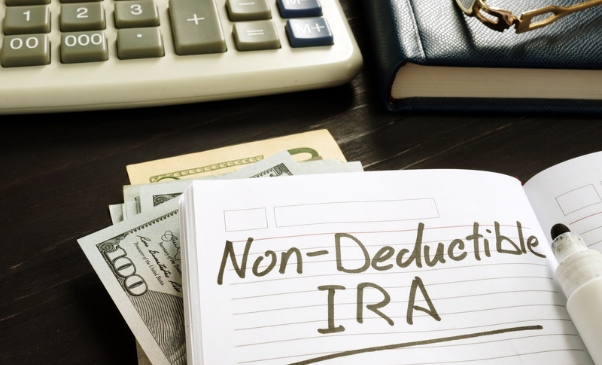Understanding Non-Deductible IRAs: Essential Insights
Oct 16, 2023 By Susan Kelly
If payments to an IRA are not tax-deductible, they are made after taxes. On the other hand, if your payments don't qualify for a tax credit, you won't have to pay taxes on the rise. These alternatives are used by high-earners to save for retirement. This post will answer any questions you may have about how to set up an Individual Retirement Account (IRA) that doesn't have to be taxed. With the help of a financial expert, you can plan for your retirement in a more informed way.

How a nondeductible IRA works:You can reduce contributions to a standard IRA from your taxable income, but transfers from a Roth IRA after retirement are not taxed. But candidates must first meet specific requirements to take advantage of most IRAs’ tax benefits.When talking about an Individual Retirement Account (IRA), "nondeductible IRA" means an IRA to which you can't get a tax break for the money you put in. You can still put money into an individual retirement account (IRA), even if you don't meet the requirements for your funds to be tax-deductible. Since any increase in your account will be taxed once you withdraw it, you'll still get some tax relief even after you stop working. Then, when you start taking money out of your retirement account, you will have to pay taxes on the gains that have been building up in the account.What Are the Benefits of a Nondeductible IRA?Most people who want to save for retirement but don't meet the standards to put money into a traditional Individual Retirement Account (IRA) because of their income level or something else use nondeductible IRAs.Because the government can't tax your retirement income twice in this way, First, how to fund a nondeductible IRA. Using the information here, you can decide whether this choice is possible.Whether or not you can subtract your IRA payments from your federal income tax bill depends on your income, how you file your taxes, and whether or not you have access to a company retirement plan. If your partner is already enrolled in a 401(k) or another type of company retirement plan, this could affect your status.What You Should Know About Nondeductible IRAsContribution limits:Individual retirement accounts (IRAs) that are not tax-deductible have the same maximum annual donation limit as tax-deductible IRAs. On the other hand, a regular payment to an Individual Retirement Account (IRA) or 401(k) immediately qualifies for a tax credit.Withdrawing contributions:Even payments that aren't tax-deductible right now can be taken out tax-free when it's time to leave. If that were the case, your payments would have to pay taxes on top of taxes. On Form 8606, people who put money into nondeductible IRAs must tell the Internal Revenue Service (IRS) that the money was put in after taxes were removed. You have to fill out this form so that you don't have to pay taxes twice on your payments when you take them out during retirement.Withdrawing gains:When financial gains are cashed out, the gains are taxed at the rate that applies to the person. In contrast to regular IRAs, earnings can be taken out of Roth individual retirement accounts (IRAs) and Roth 401(k)s without taxation.

Should You Contribute to a Nondeductible IRA?If you or your partner make too much money to qualify for tax-advantaged retirement plans, putting money into a nondeductible IRA is a simple way to save money and grow tax-free until you need it in retirement. The tax benefits of these contributions are the same as those of Roth IRA contributions.Please be aware that a nondeductible IRA has tax benefits different from those of other retirement plans. Remember to file your yearly tax returns with the IRS to get credit for your payments, even if they aren't tax deductible, so that you don't have to pay taxes twice on the money you take out of your retirement account.Pros & Cons of Nondeductible IRAsPeople who don't meet the requirements for tax-deferred retirement funds may find that individual retirement accounts (IRAs) that are not tax-deductible are an excellent option. But they require that you keep most of your notes on time.Pros:
- It allows you to put more money into your retirement plan than the law allows.
- The money you take out of your account will not be taxed.
- As long as you meet the requirements set by the IRS, you can keep making donations for as long as you want.
- Donors can make as much money as they want.
Cons:
- Since there is no direct benefit to a person's taxes,
- After taxes are paid, the money left over is used for donations.
- You need to keep track of all the money you put into the account so you don't have to pay taxes on any withdrawals.
- You must always include Form 8606 with your tax return when you send it in.
- You might have to pay a penalty if you take money out of your retirement account before you are 59 and a half.
Considerations of a Nondeductible IRA:Moving traditional individual retirement accounts (IRAs) to Roth IRAs allows you to build up a large amount of money quickly. But fixed IRAs that aren't tax-deductible come with some risks that should be addressed. One way to solve one of the most critical problems, which is how to avoid paying taxes twice on the same income, is to keep your tax-deductible and non-tax-deductible gifts in different accounts. When all the gifts are added together, it is harder to tell which ones count for a tax credit and which do not.It's not that easy, but you can do it if you keep careful records of what you give. Next, you'll have to determine how much of your IRA contributions were made after taxes. To do this, divide the total amount of your nondeductible contributions by the total amount of your IRA donations. As long as you don't start taking cuts from your income, the federal government won't tax this part of the account's possible growth that is open to taxation. As soon as you start taking deductions, though, you'll have to start paying taxes on this part of the account's growth in the usual way. Your "basis" is the total amount of money you put into your retirement account (IRA) after taxes.Conclusion:If you can't put money into a standard IRA because of taxes, you may still benefit from investment gains that aren't taxed immediately by setting up a Roth IRA. The type of retirement plan that most financial advisors suggest is the Individual Retirement Account (IRA) with Roth payments. But the Roth 401(k) is mostly made so that workers who make a lot of money can start a Roth individual retirement account (IRA). Pay close attention to all the change limits so you stay within the rules set by the Internal Revenue Service (IRS) and end up with a big tax bill you could have avoided.

How to Hire a Retirement Advisor? What You Need To Know

What Is An Interest-Only Loan: A Complete Understanding

BECU rolls out same-day payments

What Is the Difference Between Stocks and Index Funds: A Quick Overview

Review of Country Insurance's homeowner plan

What You Should Know About Mistakes In Debt Consolidation

Are Debt Collectors Allowed to Message or Text People

How to Get Unemployment Pay

Should You Consider A HELOC On Your Investment Property?

